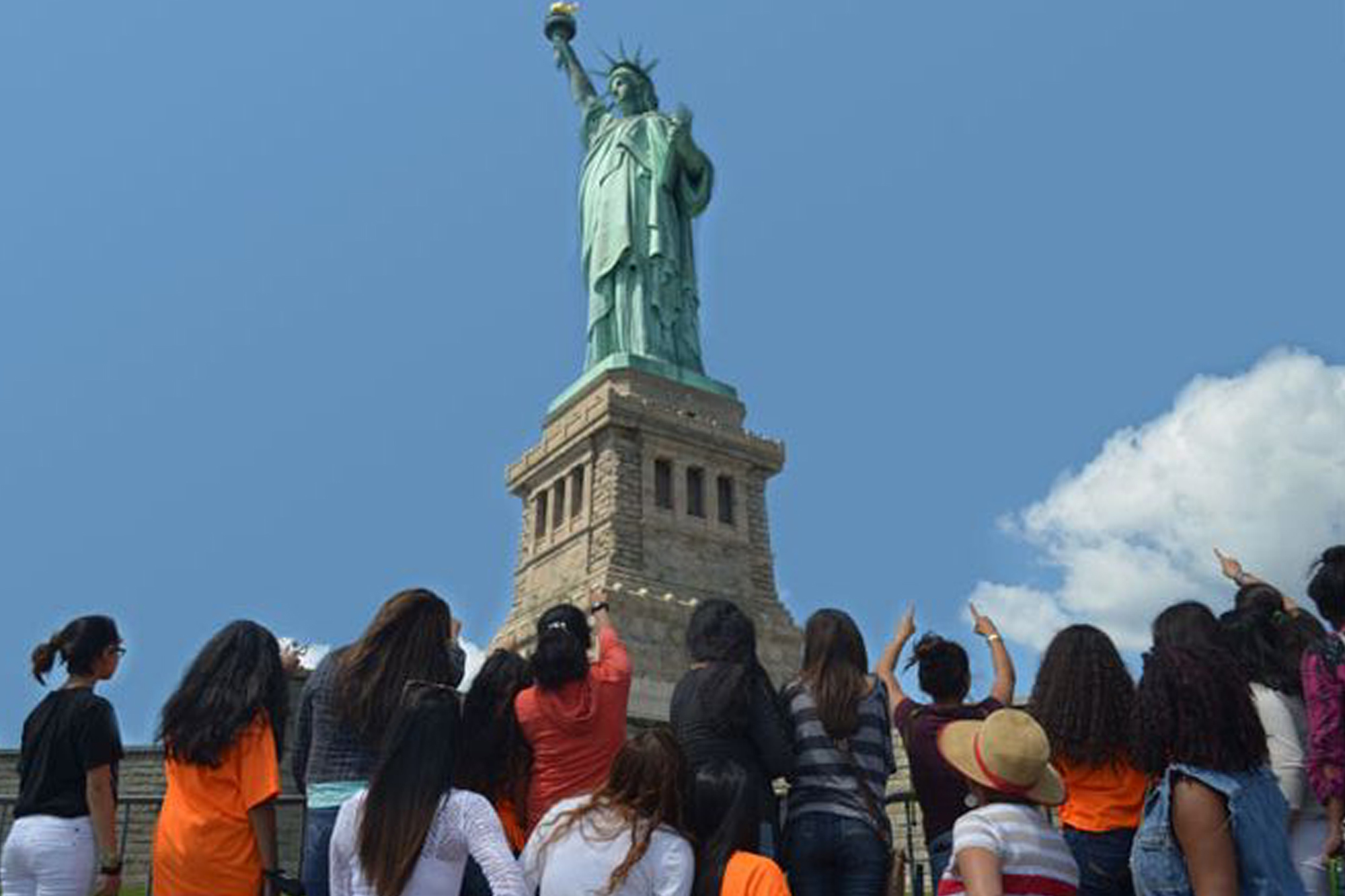Published originally by Johns Hopkins University, Lifelines: Stories from the Human Safety Net, 2014
A team of bilingual, bicultural social workers try to help at-risk girls
Five years ago, a 12-year-old Latina girl committed suicide in her family’s garage in the town of Westbury, NY, a diverse suburb on Long Island that has pockets of poverty and has seen an influx of immigration from Central and South American countries in the last few decades.
The town – adjacent to Old Westbury, which was cited by Forbes Magazine as the 10th most expensive zip code in the United States–is rife with overcrowded, rundown multi-family housing, and a large percentage of the population is struggling to make ends meet. Day laborers wait on corners in hopes of picking up some jobs. Many of the immigrants speak little or no English. Some are undocumented, making them hesitant to reach out for legal, medical or mental health services. Even if they are willing, they can’t apply for a driver’s license and therefore are unable to travel to appointments.
It’s an unsafe and stressful environment for anyone, but especially perilous for teenage girls.
While it’s unclear exactly what led to this particular girl’s suicide, her desperate action wasn’t an isolated event, according to Regina Barros-Rivera, Associate Executive Director at North Shore Child & Family Guidance Center, a not-for-profit children’s mental health agency whose social workers, psychiatrists, psychologists and counselors provide extensive services to residents of Nassau County, Long Island.
“We were experiencing a huge influx to our agency of Latina teens with clinical depression and suicidal thoughts,” says Barros-Rivera. “Many were failing school, exhibiting self-harming behaviors such as cutting and talking about ending their lives.”
According to the Centers for Disease Control and Prevention, (CDC), one out of every seven Latina teens attempts suicide.
Some of the girls have neurological or mental health issues, such as impulsivity connected to ADHD, Barros-Rivera notes, while others have been abused. “The girls come with different stories,” she says. “Some are suicidal because their parents are fighting all the time, and they just can’t take it anymore. Some have been sexually abused. But they all were depressed and felt that suicide was their only way out. It was a very alarming trend.”
Barros-Rivera gathered a team of bilingual and bicultural social workers and mental health counselors from North Shore Child & Family Guidance Center to review research on the topic of depression and suicide in the Latina teen population. They discovered that the trend was a nationwide problem.

Family Values
The CDC study, along with other research, indicates that the major factor contributing to the high risk of depression and suicide among first-generation Latinas is the intense pressure they’re under to adhere to the traditional values of their parents’ homeland and not become too “Americanized.”
The activities that are such an accepted part of a typical teen’s life–going to the movies, to the mall, to sleepovers–are forbidden for many Latina girls. And, if they are allowed to venture out, they’re often required to have a chaperone in the form of a parent or older brother. These unrealistic limitations make the girls feel angry, hopeless and marginalized.
In many ways, it’s not surprising that these immigrant parents are overprotective of their daughters, according to Barros-Rivera. “The families have come from very distressed lands, where they have been victims of war, violence and poverty,” she says. “Many of them have been traumatized, and they’ve come here to find safety for their children. They often hover over their daughters and watch their every move. But that leaves the girls feeling they have no way out, which creates a very dangerous situation.”

A Creative Solution
North Shore Child & Family Guidance Center’s high-risk team knew that something had to be done. The result: The Latina Girls Project, a multifaceted program for Hispanic girls (ages 12-16) that employs individual, family and group therapy, along with monthly outings and other activities, all designed to tackle issues such as depression, suicidal ideation, hopelessness and low self-esteem.
One of the program’s clients is Maria (not her real name), a 16-year-old with large, soulful brown eyes who was born in the United States to parents from El Salvador. According to Edenny Cruz, an LMSW who, along with Barros-Rivera, counseled Maria, the teen was severely depressed and suicidal when she began treatment. Her biggest complaint was that she hated school, and she was distraught and angry that her parents pushed her to attend.
“School wasn’t a healthy or safe place to be for me,” says Maria. “I was being bullied all the time. The other kids called me names and laughed at me ever since elementary school, and I felt like I wasn’t getting any support from the teachers.”
Maria tried to explain to her mother and father the reasons school was difficult for her, but “they didn’t understand,” she says. “They told me to ignore the bullies.” Maria’s parents thought she was being dramatic and defiant, not realizing that her behavior was a sign of depression.
The prevalence of not going to school because of safety concerns was highest among Hispanic females, at 12.6%. In comparison, white females report 7.4% and black females report 8%.
School refusal is a common symptom of depression and anxiety among adolescents, according to the Anxiety and Depression Association of America.
The troubled teen began to skip school, which created many heated arguments in her household. Part of the reason Maria’s parents had come to the United States was to give their children a good education–something they didn’t have in El Salvador, where they spent their days working on farms instead of studying in classrooms.
“My dad hates the fact that he can’t read or write,” says Maria. “He wants me to be more successful, so school is very important to him.”
The constant pressure and fighting at home took its toll, and Maria began to feel that suicide was her only option. “I didn’t know how to deal with everything and get rid of how I was feeling,” she says. “I felt like I was just a big bother to everyone.”
Self-Harming Behaviors
In an attempt to alleviate the pain, Maria began cutting herself–a common response to stress in teen girls.
“Some of them self harm because they feel numb,” says Barros-Rivera. “It helps them experience their pain, which paradoxically provides them with some relief. It’s also something that they are in control of, which gives them a sense of autonomy.”
According to a 2011 study, self-harm among teen girls of every nationality is common, with nearly one in 12 teens deliberately hurting themselves, most often by cutting or burning their own flesh. Self-harming is one of the strongest predictors of who will go on to commit suicide. Some of the findings:
- Self-harm is common, reported by about 8 percent of 14- to 19-year-olds.
- At every stage, more girls reported self-harm than boys.
- Those who cut, burned or otherwise deliberately hurt themselves were more likely to be seriously depressed or anxious, and to report smoking, drinking or abusing drugs.
- Similarly, a small subgroup of students who began hurting themselves as young adults were more likely to report having been depressed or anxious as teenagers.
The proportion of young men and women reporting self-harm substantially declined as they aged.
(Source: Murdoch Children’s Research Institute).
For Maria, who had carefully hidden her scars, the self-injurious behavior turned out to be the impetus for her parents to get her into treatment. “I didn’t want them to know that I was cutting myself, but one day I feel asleep on the couch at home and my shirt hiked up. When my mom saw the marks on my stomach, she cried and asked what I was doing.”
Realizing the gravity of the situation, Maria’s parents took her to a psychiatrist, who put the teen on medication. According to Maria, it didn’t alleviate her depression. “I just wanted to die,” she says. “I felt like I couldn’t make my parents happy no matter what I did.”
Maria’s parents reached out to North Shore Child & Family Guidance Center and learned about the Latina Girls Project. Maria began working with Edenny Cruz, whose mother and father were born and raised in Puerto Rico. “My parents were very strict,” says Cruz, “so when Maria and the other girls talk about the conflicts with their parents, I can tell them I know just what they’re talking about.”
Fostering a Common Bond
As with many clients, Maria was resistant to counseling at first, says Cruz. “Her attitude was, if you can’t get me out of school, what good are you?” she says. “She was very angry.”
Depression in teens can look very different from depression in adults. For some depressed teens, symptoms of irritability, aggression and rage are more prominent. A depressed teenager may be hostile, grumpy, or easily lose his or her temper.
“Depression is anger turned inward,” says Barros-Rivera. “Even though the girls are angry at themselves, they might express it by behaving defiantly or becoming physically aggressive–and their mothers are the most frequent targets of their outbursts.” In other girls, depression can lead to eating or sleeping disorders, she adds. “There’s no one profile that fits all the girls.”
Cruz’s strategy to help Maria develop trust during her therapy sessions was to focus on the teen’s other interests, which included singing and cooking vegetarian food.
“Talking about their whole lives–not just their problems–is an important way to get the girls to open up,” says Cruz. “With girls who are oppositional to treatment, I tell them we can talk about whatever they like and not the things that they are sad about. Eventually, they bring up those issues on their own.”
For Maria, an important breakthrough came when the team was able to work with her district to get her into a new school that had smaller classes and psychological support systems for at-risk students. The strategy worked, and Maria’s mood improved tremendously after the placement. “The kids there are just nicer, and they understand because they all had issues with school,” she says. “We all just kind of got each other.”
Maria was grateful that the Latina Girls Project counselors had listened to her frustrations and taken action to find a school that fit her needs. “Once I liked school,” she says, “my mind wasn’t so filled with hating everything.”

The Gender Gap
While problems such as bullying, poverty, unemployment among family members, lack of access to healthcare, and racial discrimination contribute to the teens’ depression, the cultural and gender-based expectations forced upon these girls are what create the most conflicts, according to Vilma Barber, an LCSW and member of the Latina Girls Project team.
“These girls face so many stresses that the typical American teenager doesn’t have to deal with,” says Barber. “They are expected to clean the house, cook and take care of their siblings–especially their brothers, whom they refer to as ‘the golden boys,’ ” she says. “Traditionally, boys in their culture aren’t expected to do chores, so it all falls on the girls, who are put in the role of surrogate parents.”
That was the predicament for Ana, another teen who came to the Latina Girls Project suffering from severe depression and suicidal thoughts.
Ana (a pseudonym) was born in the United States to parents from Mexico. Her father worked as a sous chef and her mother as a housekeeper; both parents were often away from home. That left the burden on her–but not her brothers.
“My brothers were treated special,” says Ana, a petite, athletic girl with thick, wavy jet-black hair. “They treated me and my sister like servants.”
“It’s very tough on the girls to be put in the position of doing everything while their brothers are given free reign,” says Barros-Rivera. “It makes them feel frustrated and insignificant.”
Ana also began her life with one huge strike against her: She was a girl–not what her father had hoped for, a fact he made crystal clear. “My dad wanted a boy,” says Ana, fighting back tears. “He told me that ever since I was little.”
According to team member Susannah Sanchez-Agosto, MA-MHC, males are valued more highly in many Hispanic families.
“The Latino culture prioritizes having a strong family unit,” she says. But that unit is highly patriarchal, with females relegated to restrictive roles. “Often you can see a mother’s care-giving for her child and submission to the father’s authority as the machista,” says Sanchez-Agosto.
The Impact of Marital Strife
In addition to bearing household responsibilities, Ana carried a lot of guilt for her parents’ failing marriage. “They fought all the time, and it was very hard,” she says. “I felt like I had to be the toughest one in the house. When my siblings and my mom were crying, I’d be the one saying, ‘Don’t cry.’ I was being the mom.”
Ana’s mother acknowledges that her daughter was under enormous pressure. “The children love their father, and our marital conflicts had a negative impact on them,” she says. But she still had a difficult time understanding why her daughter was always so irritable and sad. She compared her daughter’s life with her own impoverished childhood and felt that Ana had it easy.
“I came to the U.S. because of poverty,” says Ana’s mother, the second oldest of 12 siblings. “Many times, we would all go to sleep without having dinner.”
Those kinds of statements only made Ana feel more angry, guilt-filled and worthless. “My mom would talk about how she had to work in the fields when she was growing up and didn’t have much food to eat,” says Ana. “She’d say that my life was not nearly as hard as hers had been.”
Maria had a similar experience with her father, who blamed Maria for her problems.
“My dad would say to me, ‘I’ve given you everything, I work so hard. Why are you like this?’” she says.
When Hospitalization is Needed
All of the tensions at home led Ana to fall into a deep depression; despite being an avid reader and European history buff, she began skipping school and talking about ending her life. Her mother was so concerned that when the school called one day to say Ana had walked out, she feared that her daughter had killed herself.
“There’s a bridge by my school, and my mom thought I had jumped,” says Ana.
The school social worker recognized that Ana was in danger and recommended that she be hospitalized in an inpatient psychiatric program. Despite the difficulty of dealing with that news, Ana’s mother was grateful that the school had taken action to provide her daughter with protective care. “They made me see the seriousness of the problem,” she says.
Although Ana didn’t believe the hospital experience was helpful (“it made me feel caged in,” she says), Barros-Rivera believes that, in some cases, hospitalization is necessary.
“When it’s not clear whether the girl might act out her suicidal thoughts, the hospital is the safest place for her to be,” she says.
“They can also work to determine if she is suffering from a chemical imbalance that might be helped by medication.”
Short-term inpatient psychiatric stays increased for youth of all ethnicities but declined for older adults between 1996 and 2007, according to an August 2011 study in the Archives of General Psychiatry. Hospitalization rates increased most for children ages 5-12, going from 155 per 100,000 children in 1996 to 283 per 100,000 children in 2007. Among teens, the rate rose by about 35 percent.
But hospitalizations are typically short-term, and follow-up treatment is essential, Barros-Rivera adds. “Through the Latina Girls Project, we can help teach them how to deal with their feelings so they won’t need to go the hospital again.
Finding a Safe Place
After her release from the hospital, Ana entered the Latina Girls Project and was assigned to Vilma Barber. At first, however, both Ana and her parents were hesitant to participate in the program. “I didn’t want to come,” Ana says. “My mom cried when we came, and my dad said ‘that’s for crazy people’.”
It’s not surprising that these immigrant families are reluctant to get help, says Barros-Rivera. “Most of them had no mental health care in their countries, so it’s new to them,” she explains. “There’s a cultural taboo against seeking treatment.” Plus, for families who are undocumented, the prospect of being exposed can be frightening.
But for those who do reach out to North Shore Child & Family Guidance Center and learn about the Latina Girls Project, it quickly becomes clear that they are in a safe place. “They see that we are here to help them,” says Barros-Rivera. “And they’re so happy that we speak Spanish.”
As with most girls, it took some time for Ana to develop trust in Barber. “In the beginning, I told her that I wasn’t going to tell her anything,” says Ana.
But the teen soon realized that Barber understood her situation from personal experience, having come from a strict family in Colombia. “She knew what it was like to be in a house where the girls have to do everything and the boys are treated like princes,” says Ana. “She listened when I told her that I couldn’t do anything that my friends could do, like dating. My father didn’t even want me to look at boys.”

The Desire to Fit In
According to Barber, all of the girls’ parents are suspicious of the freedoms given to the average U.S. teen; they resist acculturation, while the girls embrace it.
“The girls go to school where teens dress in a way that their immigrant parents disapprove of,” says Barber. “They want their girls to wear dresses, not jeans. It makes the girls feel like they don’t fit in.”
Dating is taboo, with parents fearing their daughters will lose their virtue, a value highly prized in their culture. “At school, the girls hear about accepting your body and your sexuality,” says Barber. “They learn about issues like homosexuality and birth control, which are things their parents don’t discuss. The only choice in their minds is abstinence.”
Candice Crawford, an LMHC who is part of the Latina Girls Project team, says that the girls aren’t only forbidden to date, they’re not even supposed to text boys. Girls who do become sexually active are a source of shame.
“I had one mother who threatened to kick her daughter out of the house and send her back to El Salvador when she found out she was having sex,” says Crawford. “She called her a slut and said she had to pay the price.”
Language and Economic Barriers
While most of the parents speak little or no English, it is the primary language spoken by the girls. When their daughters speak English at home, says Barber, “the parents often feel a sense of betrayal at the loss of their culture, which is how they perceive it.”
For the teens, their parents’ inability to communicate among the general population can be a source of embarrassment. They want their mothers and fathers to be more like their peers’ parents, many of whom come from wealthier neighborhoods.
“The Latino families are living in these pockets of poverty within middle and upper-class suburbs,” says Barber. “Our girls go to schools where kids are going skiing and doing all sorts of things they can only dream about. It’s very isolating for them.”
All of these conflicts can add up to very unhappy family relationships, says Barber, in which the parents feel abandoned by their Americanized teens while “the girls feel engulfed, trapped and overprotected.”
A Great, Big World
Recognizing the need for the girls to venture beyond their homes and neighborhoods and experience the world around them, the Latina Girls Project team brings the teens on monthly outings to a variety of cultural, natural and recreational sites. These excursions help the girls become more independent, and they also give them respite from the strict oversight and household responsibilities so common in their families.
Although Maria initially didn’t want to participate, Cruz persuaded her by leveraging the teen’s love of music and booking a group trip to see the musical Wicked–an opportunity that Maria couldn’t resist. Soon, the outings were among the teen’s favorite activities.
The outings also helped Ana overcome her resistance to participating in peer group therapy. “I felt very shy,” she says. But when she learned about the monthly trips, her attitude shifted. “They really made me want to be part of the group.”
The Mother-Daughter Relationship
In addition to the outings and the individual counseling sessions, family therapy is a key component in fostering communication and easing conflicts. While involvement by both parents is ideal, it’s the mother-daughter relationship that is most important, according to Barros-Rivera.
“The father is a part of the process, of course, and many do come to the sessions,” she says. “But for these girls, I believe that to activate long-term change, you have to tackle the mother-daughter relationship.”
A 2008 study backs up her contention. The study states, “Conflict with the mother was especially detrimental for Latina girls; highly conflictive mother-daughter relationships were associated with increased internalizing and externalizing symptomatology, and father support added little in predicting symptomatology.”
During family sessions, the therapists help the mothers learn how to let their daughters develop a sense of independence and autonomy. “We’ve found that once we work with the mothers and help them understand how to let their girls separate from them in healthy, age-appropriate ways, the whole family heals,” says Barros-Rivera, herself the daughter of strict immigrant parents from Chile. “We help them see each other’s perspectives and foster healthier communication.”
When fathers do participate in the family sessions, it often serves to help them to see their own behaviors in a new light.
“Traditionally, the parenting roles are very distinctly defined, whereby the father is the primary breadwinner and the mother the primary caregiver,” explains Sanchez-Agosto. “With family therapy, the father gains a stronger sense of his co-parenting role, becoming more involved as an emotional support.”
The goal, she adds, is to involve as many of the family members as possible. “The inclusion of the extended family is a source of strength, wisdom and influence in the nuclear Latino family.”

The Benefits of Group Support
Peer group therapy is also an important component of the program, with parents meeting in one group and the teens meeting in another.
“In these groups, both the parents and teens are embraced and supported by those who understand their feelings,” says Barros-Rivera. “It’s such an important tool toward healing for the whole family.”
In the girls’ support group, the team helps the teens identify and practice better ways of handling their stress. The group also serves as an avenue for the girls to mature and develop mentoring skills, according to Barros-Rivera. “The ones who have begun to get better are great at engaging the new girls,” she says. “They’ve been in the same spot, and it makes them feel good about themselves when they can help others. It builds their self-esteem.”
At the parent support group, parents (mostly mothers) learn how their overprotective behavior impedes their daughters’ growth. “The mothers work hard in the group, where they’re allowed to express their fear,” says Barros-Rivera. “We discuss things like communicating with your daughter, allowing them to have friends over, and adolescent sexuality.”
In fact, says Barros-Rivera, the group suggested that Planned Parenthood be invited to speak at one of their meetings. “That was an amazing accomplishment for the program goals,” says Barros-Rivera.
Major Shifts in Family Dynamics
According to Maria, her parents’ participation in the support groups marked a major turning point; they became more understanding of her depression and let go of their self-blame, which enabled them to focus on their daughter’s needs. “They realized that I just wanted them to be there for me and listen,” says Maria. “They learned that it doesn’t help to question why I feel the way I do but to accept it and support me.”
The program has also helped many of the mothers become firmer with their sons and more understanding of their daughters’ desire to identify as American teenagers. Says Ana’s mother, “I communicate better with my daughter, and she has a chance to socialize with children who have similar problems.”
Barros-Rivera is thrilled to witness such transformations in the family dynamic. “It’s so important for the girls to get permission from their parents to move on and take advantage of the opportunities this country has to offer,” she says, adding “I love these girls.”
Moving Forward
According to Barber, once Ana saw that her mother understood her need for freedom and respite from the parental role she had taken on, the teen learned to embrace her role in the family, seeing herself less as a “parentified child” and more as a “broker,” says the counselor.
“She feels proud that she can help her siblings while their mom is at work,” says Barber. “And she no longer feels resentful about helping her mother with English translations. It makes her feel important.”
As her confidence grew, Ana – a baseball and softball fan – took a self-defense class, and she’s developed a passion for the practice. She also decided to join a school group that focuses on values such as diligence, leadership, physical fitness and responsibility.
“Ana has definitely embraced those values,” says Barber. “Having come from a family where her father told her girls aren’t strong, this is a huge shift for her.”
Although Ana’s parents are no longer together, her relationship with her father has improved
significantly. He bought her a piano, and she’s been learning to play one of her favorite songs: “Don’t Stop Believing” by Journey.
Empowered and self-confident, both Ana and Maria have put their difficulties behind them and are making plans for the future. Ana hopes to leverage her athleticism and desire to help others by becoming a law enforcement official. While the teen acknowledges that her favorite television shows influenced that ambition, she says her main motivation is to help others, like her parents, who don’t have papers and are prey for unscrupulous people.
“There are so many scams out there, and it makes me so mad,” says Ana. “I want to do something to make a difference for people who can’t speak up for themselves.”
Maria is also highly motivated to reach her goals, which include going to a performing arts college and becoming a professional singer. “The program helped me to not be afraid to talk or sing in front of people,” she says. “I first sang in front of my family, and they clapped, so I felt confident enough to sing in front of my school.” She also sang at a celebration for the funders of the Latina Girls Project, bringing many of the audience to tears with her beautiful, heartfelt performance of a song called “Warrior” by her favorite singer, Demi Lovato, who was diagnosed with bipolar disorder in 2011 and has become an advocate for those with mental illnesses.
Most recently, Maria had the opportunity to record the song at a professional studio, which she calls one of the best experiences of her life. “She was so full of joy the entire time,” says Barros-Rivera, who was there for the session. “Her beautiful smile lit up the room.”
The Land of Hope and Dreams
Although their treatment has concluded, Ana and Maria, as with all graduates, are still invited on the monthly outings, which help expose them to possible career paths.
“They leave here knowing that there are options for them in this country,” says Barros-Rivera. “After we work with them in the program, they see hope; they see that there are other ways to deal with life’s challenges. They’ve developed self-reliance and self-esteem, and they no longer feel suicidal.”Barber and the entire Latina Girls Project team are incredibly proud of the progress Ana and Maria have made. “They’re very smart girls,” says Barber. “They’ve learned that it’s not a betrayal to their parents for them to want more out of life than being a caretaker for their families.”














